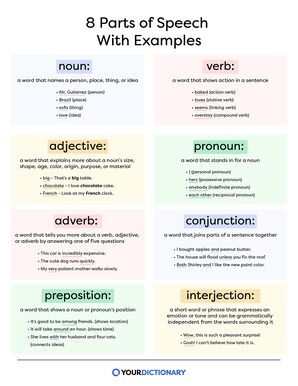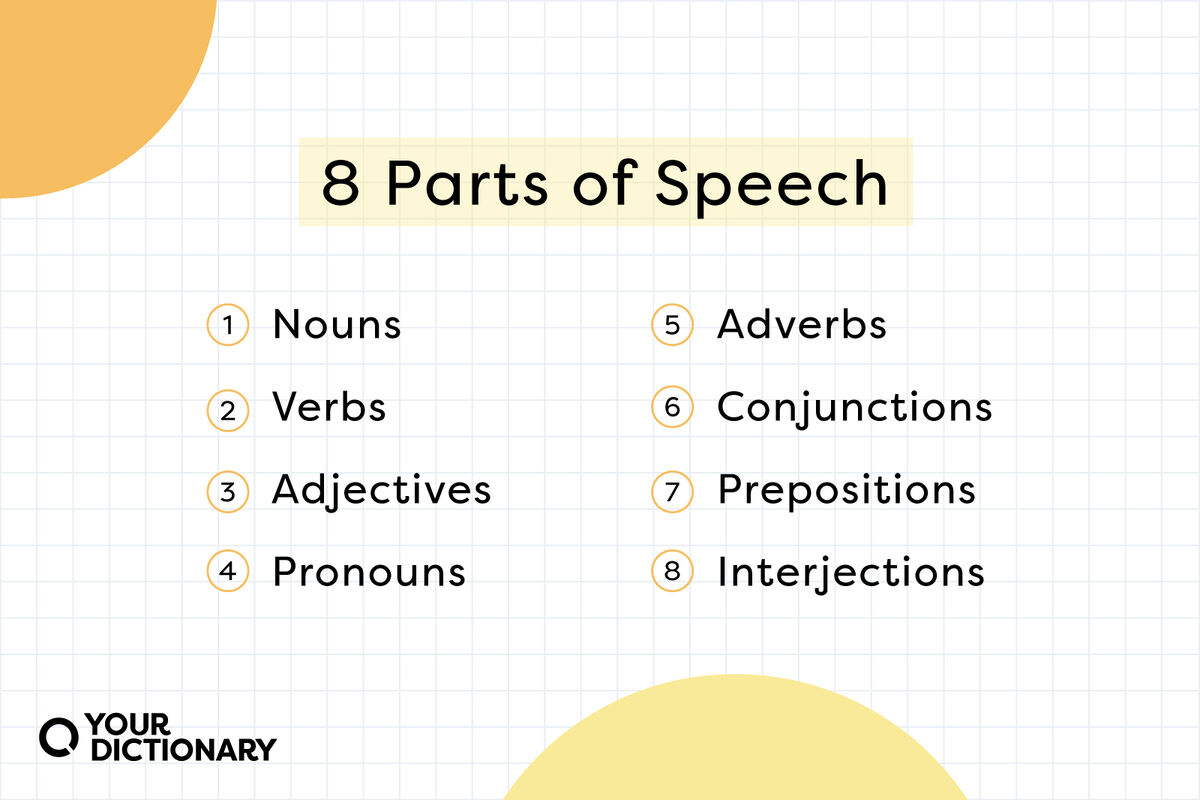

There are eight parts of speech in English: nouns, verbs, adjectives, pronouns, adverbs, conjunctions, prepositions, and interjections. While some parts of speech are more common or versatile than others, they’re all stacked like bricks in a sentence — and you can’t move one without bringing the whole sentence (or wall) down around it. These parts of speech examples demonstrate how each part of speech works, and how they modify or link to each other.
What Is a Part of Speech?
A part of speech is a word with a specific purpose in a sentence. You can categorize every English word into these parts of speech, based on what they do.

For example, nouns are the people, places, and things in a sentence, and verbs are what they do. But while every sentence requires a noun and a verb, those aren’t the only parts of speech you’ll find in writing.

1. Nouns
Nouns name a person, place, thing, or idea. They function as the subject or the object of a sentence — the person or thing that either performs the action or receives the action.
Examples of nouns include:
- Send in the clowns.
- Brazil is a beautiful country.
- I love listening to music.
- How many cats do you have?
- Mia and Zoe value their friendship.
2. Verbs
Verbs express action or a state of being. They're what you (or any nouns) do. When you change the verb's tense, you show that an action was done in the past, present, or future.
Examples of verbs include:
- We walked to the park.
- Janine has been to Minneapolis.
- That dog smells funny.
- You will need your snow boots today.
- My class is going to the museum.
3. Adjectives
Adjectives modify or describe a noun. They typically come before the noun they describe.
Examples of adjectives include:
- The sleepy bear hibernated all winter.
- It's a long drive, but it's worth the trip.
- Should I buy the blue jeans or the purple sweater?
- The twelve-year-old boy asked a question.
- Place the large silver spoon on the table.
4. Pronouns
Pronouns replace nouns to simplify speech and writing. They function as subjects and objects in sentences, just like nouns.
Examples of pronouns include:
- She is the smartest kid in class.
- George took the book from him.
- Who is coming to the party tonight?
- Don’t touch that cup; it’s mine.
- They really like their pottery class.
5. Adverbs
Adverbs modify or describe a verb, adjective, or another adverb. They provide information about an action’s time, place, manner, frequency, or degree.
Examples of adverbs include:
- Joe grumpily got out of bed.
- Sara ran very quickly to school.
- Your brother is very rude.
- I’ll have that done tomorrow.
- That's quite expensive, don't you think?
6. Conjunctions
Conjunctions connect parts of a sentence. They can join words, phrases, or clauses to add more information to a sentence.
Examples of conjunctions include:
- You'll need to study all night if you want to pass tomorrow's test.
- Go to the store and buy some milk.
- Kristopher doesn't have enough experience. Therefore, we will not hire him.
- I’d love to make dinner, but my stove isn’t working.
- We made you this quilt because we love you.
7. Prepositions
Prepositions show relationships between nouns in a sentence. They show the location of a noun relative to another noun or pronoun.
Examples of prepositions include:
- Between you and me, I wouldn't trust Andy.
- The coffee shop is across the street.
- Put the carrots in the refrigerator, please.
- Should we add more sugar to the batter?
- Mark works with my sister at the bank.
8. Interjections
Interjections interrupt sentences to show emotions. You can separate them from a sentence with a comma, period, or exclamation point, depending on the emotion.
Examples of interjections include:
- Bah, who cares what they think anyway?
- If Cody asked me out on a date, gosh, that'd make my day.
- I spilled the coffee everywhere. Oops!
- Hey! That’s my train ticket!
- Oh no. I think I failed my math test.
Are Articles and Determiners Parts of Speech?
Two additional parts of speech — articles (a, an, the) and determiners (that, my, some) — also appear in sentences. So why are there only eight parts of speech instead of ten?
While some style guides and lists may add articles and determiners to the parts of speech, these parts of speech are technically adjectives. They modify nouns to add specificity to a sentence.
These example sentences show articles and determiners in bold, while the nouns they modify are underlined.
- The detective asked me some questions.
- I gave my brother an umbrella.
- He found several kittens in the shed.
- Do you want any milk?
- Please hand me those tools.
Building New Sentences, One Brick at a Time
Learning the parts of speech is just the first step to building a proper sentence. But parts of speech are slightly different from parts of a sentence — and you need to know both in order to properly format your writing. Otherwise, you may encounter grammatical errors such as sentence fragments or run-on sentences.